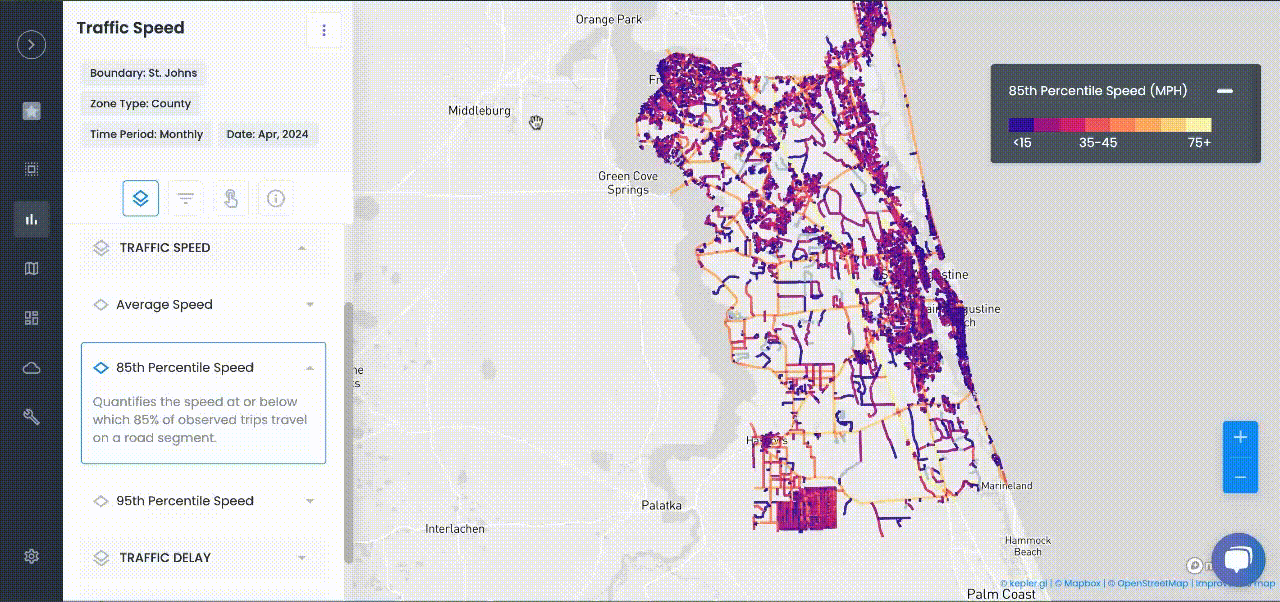
Traffic Calming
Smart Traffic Calming: How Local Governments Are Making Streets Safer
Local governments are using Geospatial AI and smart technology to reduce speeding and improve traffic safety on neighborhood streets.
Local governments are using near real-time data and smart technology to reduce speeding and improve traffic safety on neighborhood streets with Geospatial AI like Urban SDK.
In the heart of every city lies its neighborhoods — the places where families walk their dogs, children ride their bikes, and seniors stroll to local parks. These streets are not just passageways for vehicles; they are living spaces, shared by everyone. But in recent years, rising vehicle speeds, cut-through traffic, and a growing number of pedestrian and cyclist fatalities have raised critical questions about how we keep our streets safe. While traditional traffic calming methods have played a vital role, a new approach is emerging — one rooted in real-time data, predictive analytics, and smarter decision-making.
This article explores how U.S. cities are rethinking neighborhood traffic safety through a smarter, data-driven approach grounded in measurable insights. With Urban SDK tools, local governments are able to shift from reactive planning to proactive problem-solving — enabling them to identify risky patterns, target interventions precisely, and create safer streets for everyone.

Why Neighborhood Streets Demand a Modern Traffic Calming Strategy
Over 40,000 people die on U.S. roads every year — a staggering number that has risen in recent years despite advances in vehicle safety. Neighborhood streets, once considered low-risk zones, have increasingly become dangerous due to speeding, distracted driving, and poor street design. Pedestrians and cyclists — especially children, seniors, and individuals with disabilities — face the highest risk. For many communities, safety concerns have turned into barriers to walking, biking, and even socializing outdoors.
Cities have responded with traffic calming measures: physical and visual techniques designed to reduce vehicle speeds and improve safety. These include speed humps, raised intersections, curb extensions, and road diets. But while effective in specific contexts, these traditional methods often fall short when deployed without supporting data. Many are based on resident complaints, outdated studies, or political pressure — rather than objective insights into where and when danger actually occurs.
To solve today’s problems, cities need more than just paint and concrete. They need data — and they need it in real time.
Traditional Traffic Calming: Strengths and Shortcomings
Traditional traffic calming measures have been around for decades. They aim to slow down traffic, discourage cut-through driving, and improve safety by changing the physical layout or visual feel of a street. Common tools include:
- Speed humps and bumps – raised pavement sections designed to force drivers to slow down.
- Curb extensions and bulb-outs – narrowing intersections to shorten pedestrian crossings and calm traffic.
- Chicanes and serpentine curves – deliberate curves added to a straight road to prevent speeding.
- Road diets – reducing the number of lanes to lower speeds and providing room for bike lanes or wider sidewalks.
These interventions work, particularly when designed based on local context and supported by community engagement. However, they’re not always targeted efficiently. Cities often lack detailed information about which streets need interventions most, or how effective past efforts have been. Furthermore, these solutions are often expensive, slow to implement, and difficult to scale across an entire city.
The traditional approach tends to be reactive: something bad happens — a crash, a complaint — and then action is taken. This delay not only risks public safety but also undermines public confidence in government responsiveness.
The Case for a Smarter, Data-Driven Approach
In contrast, data-driven traffic calming allows cities to move from reaction to prediction. Using a combination of real-time data, historical trends, and geospatial intelligence, transportation agencies can now detect safety risks before they lead to crashes — and intervene in ways that are precise, cost-effective, and equitable.
This modern approach answers key questions:
- Where are vehicles consistently speeding?
- What time of day do risks peak?
- Are school zones and pedestrian-heavy areas being respected?
- Are recent traffic calming installations having the desired effect?
- Where should cities invest next for the greatest impact?
Urban SDK enables cities to collect, visualize, and act on these insights. By leveraging connected vehicle data, crash reports, traffic sensors, and GIS overlays, agencies can gain a citywide view of street behavior — updated hourly, not annually.
Real-Time Speed Monitoring Without the Hardware
Traditionally, collecting speed data meant placing a radar gun or rubber tube counter on a street and manually analyzing results. This method is labor-intensive, costly, and only provides a snapshot.
With Urban SDK, cities no longer need physical sensors to track speed. The platform leverages connected vehicle data — anonymized information transmitted by cars, delivery fleets, and mobile navigation tools — to map average and percentile speeds across every road segment in the network. The platform enables officials to track both real-time and historical speeds, analyze compliance with posted limits, identify persistent speeding hotspots, and evaluate traffic behavior across different times of day.
This level of insight allows planners to quickly validate resident complaints, identify unknown problem areas, and take fast action.
Predictive Crash Risk Analysis
Understanding where crashes have occurred is important — but knowing where they’re likely to occur is even more powerful. Urban SDK’s platform offers a collision risk model based on multiple data inputs: five years of crash history, traffic volumes, road type, speed behavior, and built environment features.
The result is a predictive safety index that highlights areas of concern before crashes happen. This proactive analysis helps cities prioritize interventions with confidence, reducing injuries and saving lives through smarter planning.
For example, a street with moderate speeds but a high density of schools and unmarked crossings may rank higher in risk than a busy arterial with good signage. Without data, such nuance would be hard to capture.
Evaluating the Impact of Safety Interventions
One of the most frustrating challenges in transportation planning is not knowing whether a new project actually worked. Traditional traffic calming often lacks post-installation evaluation, leaving decision-makers guessing.
Urban SDK solves this by providing before-and-after analytics on speed, volume, and crash trends. If a city installs flashing crosswalk beacons, traffic circles, or signal timing adjustments, officials can monitor the change in compliance almost immediately. If speeds decrease and pedestrian yield rates increase, it’s a success. If not, the data helps guide further adjustments.
This feedback loop turns every intervention into a testable hypothesis — fueling continuous improvement and smarter scaling.
Advancing Equity in Traffic Safety
A common criticism of traffic calming is that it disproportionately benefits well-connected or politically vocal neighborhoods. Communities with fewer resources or less engagement may be overlooked — even if they face greater risks.
Data-driven platforms help reverse this imbalance by providing visibility into every neighborhood, regardless of income or political influence. Urban SDK’s mapping tools allow agencies to layer demographic data, land use, and historical crash records — helping planners identify underserved areas with urgent safety needs.
This equitable lens is essential for cities striving to meet Vision Zero goals, reduce disparities in infrastructure investment, and build trust with marginalized communities.
Community Engagement with Transparency
Residents are the eyes and ears of any neighborhood. But too often, their complaints get lost in bureaucracy or are dismissed due to a lack of “proof.” Data-driven traffic calming enables a two-way relationship between the public and decision-makers.
With Urban SDK, planners can validate public concerns with objective data, explain decisions more clearly, and even share dashboards publicly. This transparency helps shift conversations from conflict to collaboration — aligning city priorities with community needs.
When residents see their feedback turned into action — or understand why a specific road wasn’t prioritized — trust is built, and future engagement increases.
Real-World Use Cases: Smarter Traffic Calming in Action
Across the U.S., cities are already using data-driven tools to make neighborhood streets safer. In Florida, for example, one municipality used Urban SDK to monitor speeds across its school zones in real time. When elevated speeds were detected near three elementary schools, the city deployed temporary signage and enforcement. Within one month, average speeds dropped by 15%, and compliance rates surged.
In another case, a mid-sized city in the Midwest used the platform’s collision risk analysis to secure a federal safety grant. By identifying and justifying improvements to a high-risk corridor — one not previously flagged through traditional methods — they unlocked funding for pedestrian islands, curb extensions, and protected bike lanes.
In California, a city integrated Urban SDK with its public engagement portal. Residents could see speeding patterns on their block, learn what calming measures were under consideration, and offer feedback through a simple dashboard — all updated weekly.
These examples demonstrate how real-time intelligence leads to better results, faster.
To see more examples of Urban SDK’s public sector impact, explore our Customer Success Stories.
Overcoming Implementation Challenges
Transitioning to a data-driven approach comes with challenges: budget limitations, legacy systems, and concerns about data privacy or staff training. But these hurdles can be overcome.
Urban SDK is designed to work with existing GIS and traffic systems, reducing implementation friction. Its user-friendly dashboards require minimal training, and its datasets are anonymized, ensuring individual privacy is protected. Moreover, the platform supports custom reporting — making it easy to communicate insights to city councils, grant agencies, or the public.
For agencies with limited staff or technical expertise, Urban SDK’s customer success team provides hands-on support — ensuring each city gets the most from its investment.
The Role of Technology in Future Traffic Calming
Looking ahead, the integration of emerging technologies will only deepen. Artificial intelligence, machine learning, and vehicle-to-everything (V2X) communication are poised to transform how we manage road safety.
Imagine autonomous shuttles adjusting their behavior based on live traffic calming data. Or smart intersections that detect speeding patterns and automatically deploy visual cues to slow vehicles. Or community dashboards that gamify safety, encouraging residents to track improvements and share results.
Urban SDK is already preparing for this future — developing tools that enable not just monitoring but action automation. The goal: streets that adapt in real time, just like the people who use them.
Conclusion: Safer Streets Begin with Smarter Decisions
Neighborhood streets should be safe for everyone — not just for vehicles. To achieve that, cities must move beyond one-size-fits-all solutions and toward precision, transparency, and equity.
By embracing data-driven traffic calming, local governments can make better decisions faster, respond to real problems with real solutions, and build the kind of streets people feel proud to live on. With Urban SDK, agencies have the tools they need to lead this transformation — not years from now, but today.
The future of traffic calming isn’t just about slowing cars. It’s about accelerating safety, accountability, and smarter planning — one block at a time.

TRAFFIC ENFORCEMENT FEATURES
80% of citizen complaints
are a perception problem
Urban SDK provides precise hourly speed data to evaluate complaints and deploy resources efficiently for the greatest impact to public safety.
Urban SDK provides precise hourly speed data to evaluate complaints and deploy resources efficiently for the greatest impact to public safety.
Target Speeding
Identify hot spots, validate monthly speeding trends and monitor vulnerable areas like school zones.
Improve Safety
Crash and citations location information to compare speed trends month over month
Fast Response
Respond to citizen complaints sooner with address search and exportable reporting
Deploy Assets
Generate maps for traffic enforcement by time of day, location or division to deploy officers to known problem areas.
RESOURCES
Customer Success
See how public sector leaders succeed with Urban SDK.
WEBINAR
Identify speeding and proactively enforce issues
See just how quick and easy it is to identify speeding, address complaints, and deploy officers.







